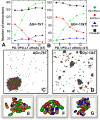A computational study of co-inhibitory immune complex assembly at the interface between T cells and antigen presenting cells
- PMID: 33684103
- PMCID: PMC7971848
- DOI: 10.1371/journal.pcbi.1008825
A computational study of co-inhibitory immune complex assembly at the interface between T cells and antigen presenting cells
Abstract
The activation and differentiation of T-cells are mainly directly by their co-regulatory receptors. T lymphocyte-associated protein-4 (CTLA-4) and programed cell death-1 (PD-1) are two of the most important co-regulatory receptors. Binding of PD-1 and CTLA-4 with their corresponding ligands programed cell death-ligand 1 (PD-L1) and B7 on the antigen presenting cells (APC) activates two central co-inhibitory signaling pathways to suppress T cell functions. Interestingly, recent experiments have identified a new cis-interaction between PD-L1 and B7, suggesting that a crosstalk exists between two co-inhibitory receptors and the two pairs of ligand-receptor complexes can undergo dynamic oligomerization. Inspired by these experimental evidences, we developed a coarse-grained model to characterize the assembling of an immune complex consisting of CLTA-4, B7, PD-L1 and PD-1. These four proteins and their interactions form a small network motif. The temporal dynamics and spatial pattern formation of this network was simulated by a diffusion-reaction algorithm. Our simulation method incorporates the membrane confinement of cell surface proteins and geometric arrangement of different binding interfaces between these proteins. A wide range of binding constants was tested for the interactions involved in the network. Interestingly, we show that the CTLA-4/B7 ligand-receptor complexes can first form linear oligomers, while these oligomers further align together into two-dimensional clusters. Similar phenomenon has also been observed in other systems of cell surface proteins. Our test results further indicate that both co-inhibitory signaling pathways activated by B7 and PD-L1 can be down-regulated by the new cis-interaction between these two ligands, consistent with previous experimental evidences. Finally, the simulations also suggest that the dynamic and the spatial properties of the immune complex assembly are highly determined by the energetics of molecular interactions in the network. Our study, therefore, brings new insights to the co-regulatory mechanisms of T cell activation.
Conflict of interest statement
The authors have declared that no competing interests exist.
Figures







Similar articles
-
Mechanistic dissection of the PD-L1:B7-1 co-inhibitory immune complex.PLoS One. 2020 Jun 4;15(6):e0233578. doi: 10.1371/journal.pone.0233578. eCollection 2020. PLoS One. 2020. PMID: 32497097 Free PMC article.
-
Structure and interactions of the human programmed cell death 1 receptor.J Biol Chem. 2013 Apr 26;288(17):11771-85. doi: 10.1074/jbc.M112.448126. Epub 2013 Feb 15. J Biol Chem. 2013. PMID: 23417675 Free PMC article.
-
Expression of programmed death 1 ligands by murine T cells and APC.J Immunol. 2002 Nov 15;169(10):5538-45. doi: 10.4049/jimmunol.169.10.5538. J Immunol. 2002. PMID: 12421930
-
PD-L1 and B7-1 Cis-Interaction: New Mechanisms in Immune Checkpoints and Immunotherapies.Trends Mol Med. 2021 Mar;27(3):207-219. doi: 10.1016/j.molmed.2020.10.004. Epub 2020 Nov 13. Trends Mol Med. 2021. PMID: 33199209 Free PMC article. Review.
-
Structural Biology of the Immune Checkpoint Receptor PD-1 and Its Ligands PD-L1/PD-L2.Structure. 2017 Aug 1;25(8):1163-1174. doi: 10.1016/j.str.2017.06.011. Structure. 2017. PMID: 28768162 Review.
Cited by
-
Effects of Metformin on JNK Signaling Pathway and PD-L1 Expression in Triple Negative Breast Cancer.Cancer Manag Res. 2024 Apr 2;16:259-268. doi: 10.2147/CMAR.S454960. eCollection 2024. Cancer Manag Res. 2024. PMID: 38585433 Free PMC article.
-
Effects of small molecule-induced dimerization on the programmed death ligand 1 protein life cycle.Sci Rep. 2022 Dec 9;12(1):21286. doi: 10.1038/s41598-022-25417-6. Sci Rep. 2022. PMID: 36494467 Free PMC article.
-
On the formation of ordered protein assemblies in cell-cell interfaces.Proc Natl Acad Sci U S A. 2022 Aug 23;119(34):e2206175119. doi: 10.1073/pnas.2206175119. Epub 2022 Aug 15. Proc Natl Acad Sci U S A. 2022. PMID: 35969779 Free PMC article.
References
Publication types
MeSH terms
Substances
Grants and funding
LinkOut - more resources
Full Text Sources
Other Literature Sources
Research Materials

